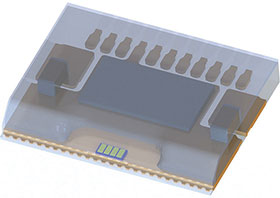

At electronica 2016, OSRAM Opto Semiconductors showcased a four-channel laser for LIDAR (light detection and ranging) systems for autonomous or semi-autonomous vehicles.
The prototype laser has an extremely short pulse length and four parallel output channels. It therefore offers completely new options for detecting objects and a unique vertical detection zone. This innovation in modern laser technology will be used for the first time in scanning LIDAR sensors based on micro-electromechanical systems (MEMS). Such solutions do not need any mechanism to redirect the laser beam so they are less susceptible to wear and tear. Together with Innoluce, an Infineon Technologies company and specialist in laser scanner technology, OSRAM is thus showing what the future of LIDAR systems may look like.
LIDAR sensors are an essential element in future fully autonomous or semi-autonomous self-driving cars. The system operates on the principle of time-of-flight measurement. A very short laser pulse is transmitted, hits an object, is reflected and detected by a sensor. From the time-of-flight of the laser beam it is possible to calculate the distance to the object.
Scanning LIDAR systems scan the surroundings of the car horizontally with a laser beam across a certain angular segment and produce a high-resolution 3D map of the environment. In most cases, the laser beams in present-day scanning LIDAR systems are deflected by means of mechanical moving mirrors. Some solutions make use of several laser diodes mounted one on top of the other to extend the vertical field of view.
The 4-channel LIDAR laser from OSRAM Opto Semiconductors consists of a laser bar with four individually controllable laser diodes and a control circuit integrated in the module. The entire module is surface-mountable, which reduces assembly costs and the time needed for fine adjustment at the customer. To create the laser bar, four laser diodes are produced next to one another in a single production step so they are precisely aligned to each other and can be individually controlled.
For the new laser OSRAM has improved its pulse laser diodes with a wavelength of 905 nm. The nanostack laser diodes now deliver a maximum optical output of 85 W at 30 A, which is approximately 10 W more than before. The pulse length of less than 5 ns is impressive compared with the previous figure of 20 ns. The short pulse length and the small duty cycle of 0,01% ensure that even at such high outputs the requirements of the relevant eye safety standards are met. With an operating voltage of 24 V the laser also meets the requirements for use in vehicles.
The overall system developed by OSRAM and Innoluce covers a field of view of 120° horizontal and 20° vertical and offers a resolution of 0,1° horizontal and 0,5° vertical. In daylight the range for detecting vehicles is at least 200 m, and for pedestrians 70 m.
For more information contact Petrus Booyens, OSRAM Opto Semiconductors, +27 (0)79 525 1779, [email protected]

© Technews Publishing (Pty) Ltd | All Rights Reserved